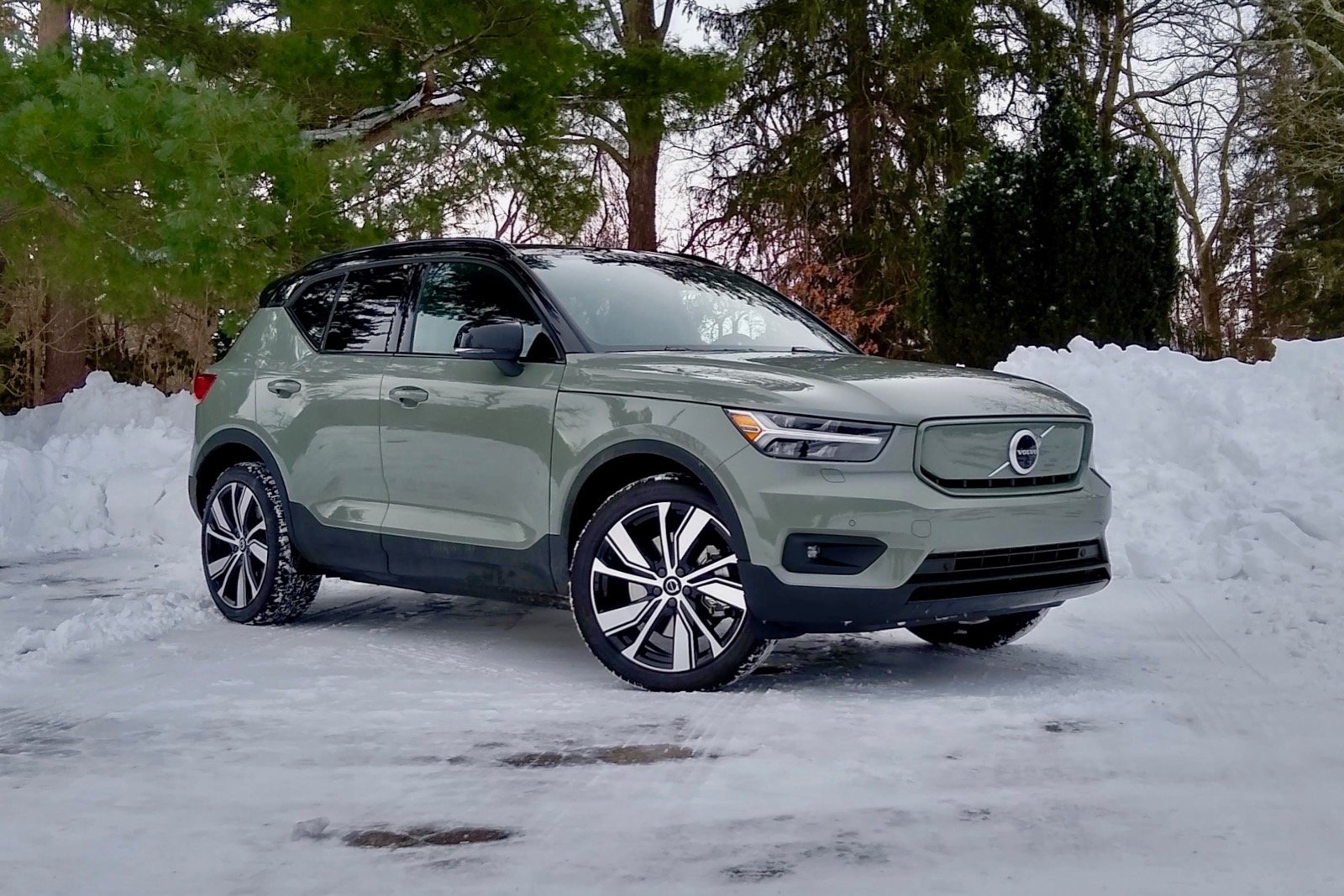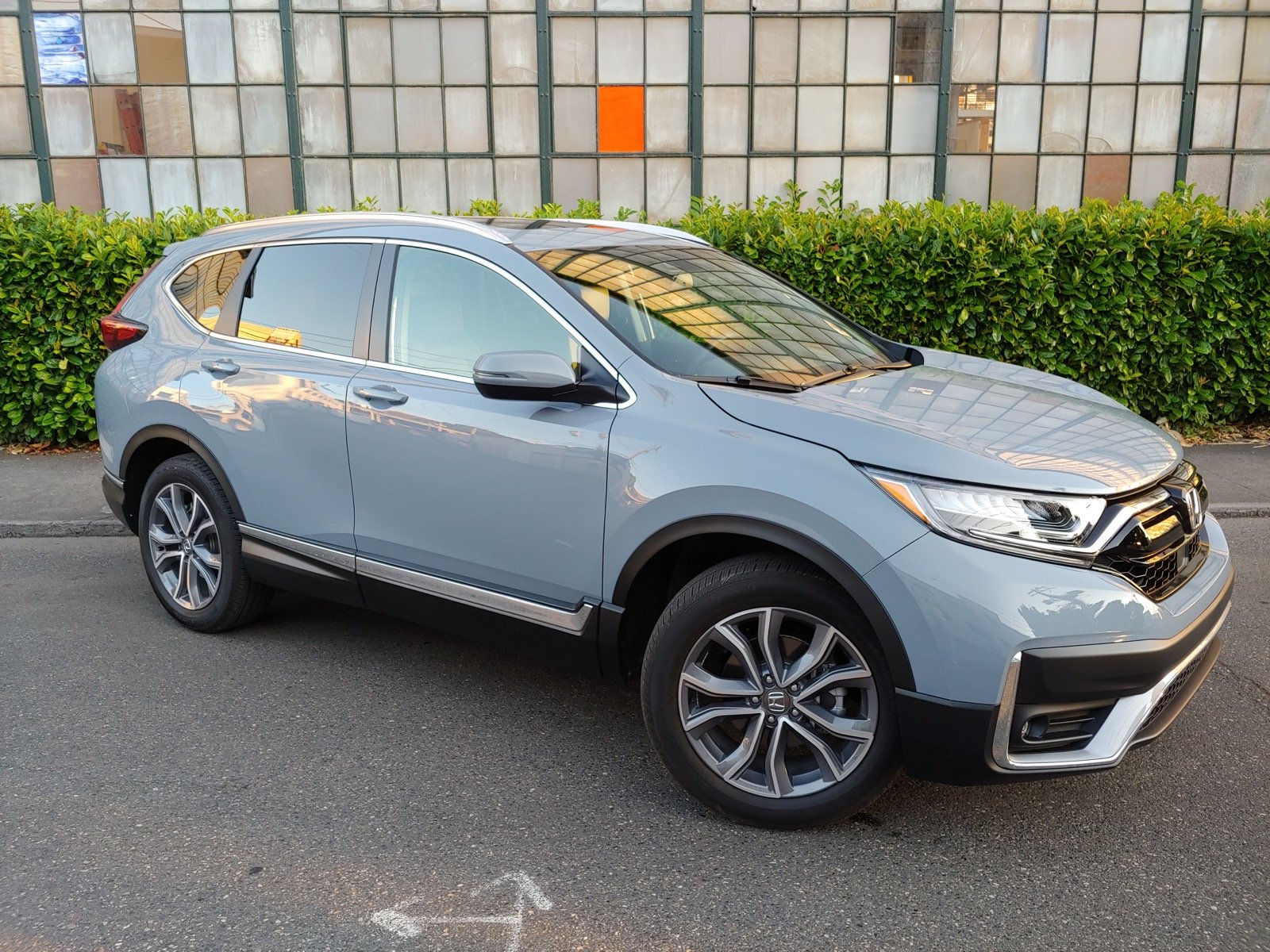2021 Volvo XC40 vs 2020 Honda CR-V
Overview | |
MSRP$25,150 | MSRP$33,700 |
Listings1672 | Listings158 |
Ratings & Reviews | |
User Reviews | User Reviews |
Expert reviews7.5 out of 10 | Expert reviews8.0 out of 10 |
Pros
Cons
| Pros
Cons
|
2020 Honda CR-V Reviews SummaryHonda’s compact SUV has been satisfying buyers for more than two decades, with more than five million CR-V’s sold. Such a legacy means the CR-V has long had its wrinkles smoothed out into a comfortable and capable crossover package that’s only downside may be its sheer inoffensiveness. This year’s model gets engine and safety upgrades, which improve fuel economy and help to make Honda’s bestseller an even better value. | |
2021 Volvo XC40 Reviews SummaryIntroduced for the 2019 model year, the Volvo XC40 enters 2021 with one major change—the addition of an all-electric powertrain option. The 2021 Volvo XC40 Recharge is the Swedish automaker’s first mass-market electric vehicle, in fact. The Recharge will be sold alongside gasoline versions of the XC40, which carry over largely unchanged, and compete against small luxury crossovers like the Audi Q3, BMW X1, Mercedes-Benz GLA-Class, and Lexus UX. With its electric powertrain, the Recharge is a de facto Tesla Model Y competitor. It’s also priced similar to high-end versions of the Ford Mustang Mach-E, although the two electric crossovers have somewhat different philosophies. In addition to that zero-emission powertrain, the Recharge gets an Android-based operating system, over-the-air (OTA) software update capability for all vehicle systems, and some updates to driver-assist tech. These changes don’t apply to gasoline 2021 XC40 models, but Volvo does plan to add the Android operating system to more vehicles in the future. Since the Recharge is the main new thing for the 2021 XC40, that’s what we focused on for this review. While the gasoline XC40 is available in three trim levels—Momentum, R-Design, and Inscription—with front-wheel drive (FWD) or all-wheel drive (AWD), the Recharge is only offered in a single trim level, with standard AWD. | |
No video found | No video found |
Popular Features & Specs | |
Engine1.5L 190 hp I4 | Engine2.0L 187 hp I4 |
Drive TrainFWD | Drive TrainFWD |
Seating Capacity5 | Seating Capacity5 |
Horsepower190 hp @ 5600 rpm | Horsepower187 hp @ 4700 rpm |
MPG City28 | MPG City23 |
MPG Highway34 | MPG Highway32 |
Engine | |
Engine Name1.5L 190 hp I4 | Engine Name2.0L 187 hp I4 |
Torque179 lb-ft @ 2000 rpm | Torque221 lb-ft @ 1400 rpm |
Horsepower190 hp @ 5600 rpm | Horsepower187 hp @ 4700 rpm |
DrivetrainFWD | DrivetrainFWD |
Fuel Economy | |
MPG City28 | MPG City23 |
MPG Highway34 | MPG Highway32 |
Interior | |
Leather Seats | Leather SeatsStandard |
Seating Capacity5 | Seating Capacity5 |
Safety | |
Front Crash Overall5 | Front Crash Overall5 |
Side Crash Overall5 | Side Crash Overall5 |
Dimensions & Capacity | |
Cargo Space39.2 cu ft | Cargo Space20.7 cu ft |
Curb Weight3337 lbs | Curb Weight3627 lbs |
Height66.1 in | Height65.3 in |
Length182.1 in | Length174.2 in |
Width73.0 in | Width80.1 in |
Wheelbase104.8 in | Wheelbase106.4 in |
Maximum Payload1358 lbs | Maximum Payload1133 lbs |
Number of doors4 | Number of doors4 |
Maximum Towing Capacity1500 lbs | Maximum Towing Capacity3500 lbs |
Overview | ||
MSRP | $25,150 | $33,700 |
Listings | ||
Ratings & Reviews | ||
User reviews | ||
Expert reviews | 7.5 out of 10Read full review | 8.0 out of 10Read full review |
Pros & cons | Pros
Cons
| Pros
Cons
|
Summary | Honda’s compact SUV has been satisfying buyers for more than two decades, with more than five million CR-V’s sold. Such a legacy means the CR-V has long had its wrinkles smoothed out into a comfortable and capable crossover package that’s only downside may be its sheer inoffensiveness. This year’s model gets engine and safety upgrades, which improve fuel economy and help to make Honda’s bestseller an even better value. | Introduced for the 2019 model year, the Volvo XC40 enters 2021 with one major change—the addition of an all-electric powertrain option. The 2021 Volvo XC40 Recharge is the Swedish automaker’s first mass-market electric vehicle, in fact. The Recharge will be sold alongside gasoline versions of the XC40, which carry over largely unchanged, and compete against small luxury crossovers like the Audi Q3, BMW X1, Mercedes-Benz GLA-Class, and Lexus UX. With its electric powertrain, the Recharge is a de facto Tesla Model Y competitor. It’s also priced similar to high-end versions of the Ford Mustang Mach-E, although the two electric crossovers have somewhat different philosophies. In addition to that zero-emission powertrain, the Recharge gets an Android-based operating system, over-the-air (OTA) software update capability for all vehicle systems, and some updates to driver-assist tech. These changes don’t apply to gasoline 2021 XC40 models, but Volvo does plan to add the Android operating system to more vehicles in the future. Since the Recharge is the main new thing for the 2021 XC40, that’s what we focused on for this review. While the gasoline XC40 is available in three trim levels—Momentum, R-Design, and Inscription—with front-wheel drive (FWD) or all-wheel drive (AWD), the Recharge is only offered in a single trim level, with standard AWD. |
Video | No video found | No video found |
Popular Features & Specs | ||
Engine | 1.5L 190 hp I4 | 2.0L 187 hp I4 |
Drive Train | FWD | FWD |
Seating Capacity | 5 | 5 |
Horsepower | 190 hp @ 5600 rpm | 187 hp @ 4700 rpm |
MPG City | 28 | 23 |
MPG Highway | 34 | 32 |
Engine | ||
Engine Name | 1.5L 190 hp I4 | 2.0L 187 hp I4 |
Torque | 179 lb-ft @ 2000 rpm | 221 lb-ft @ 1400 rpm |
Horsepower | 190 hp @ 5600 rpm | 187 hp @ 4700 rpm |
Drivetrain | FWD | FWD |
Fuel Economy | ||
MPG City | 28 | 23 |
MPG Highway | 34 | 32 |
Interior | ||
Leather Seats | Standard | |
Seating Capacity | 5 | 5 |
Safety | ||
Front Crash Overall | 5 | 5 |
Side Crash Overall | 5 | 5 |
Dimensions & Capacity | ||
Cargo Space | 39.2 cu ft | 20.7 cu ft |
Curb Weight | 3337 lbs | 3627 lbs |
Height | 66.1 in | 65.3 in |
Length | 182.1 in | 174.2 in |
Width | 73.0 in | 80.1 in |
Wheelbase | 104.8 in | 106.4 in |
Maximum Payload | 1358 lbs | 1133 lbs |
Number of doors | 4 | 4 |
Maximum Towing Capacity | 1500 lbs | 3500 lbs |
The 2020 Honda CR-V, representing the fifth generation of Honda’s compact crossover, had already established itself in the market since its debut in 2017. With a soft design approach filled with curvy and car-like lines, it bore a strong family resemblance to Honda’s sedans, particularly in the front and rear fascias. Externally, the CR-V leaned more towards a station wagon aesthetic compared to an SUV, creating a modern family transportation vibe.
However, the interior of the CR-V appeared somewhat inconsistent. While higher trims featured attractive wood-look trims and leather upholstery, they mingled awkwardly with some low-quality plastics, reminding drivers that even the pricier CR-Vs were essentially upgraded commodity vehicles rather than true premium cars. With a base MSRP of $26,270 for the LX front-wheel-drive (FWD) model, the CR-V offered four trim levels—LX, EX (starting at $28,720), EX-L ($31,270), and Touring ($24,470)—each available with all-wheel drive (AWD) for an extra $1,500.
Standard on the CR-V were 17-inch alloy wheels, while EX trims upgraded to 18-inch wheels, and the Touring saw optional 19-inch wheels as standard. Fabric seating adorned the two lower trims, with leather available on the upper trims. Additionally, the EX and above trims featured a retractable moonroof, though it was less expansive than the panoramic sunroof found in competitors like the RAV4 and Tiguan. The top-tier Touring model alone boasted roof rails, which, despite their functionality, were decidedly low-profile.
Contrastingly, the 2021 Volvo XC40 exhibited more traditional SUV styling, highlighted by its tall, flat roof, and upright rear hatch, slotting seamlessly into Volvo's lineup with its signature “Thor’s Hammer” LED headlights and simple oval grille. While gasoline models came with a white contrasting roof for a retro aesthetic, the electric XC40 Recharge differentiated itself with a blanked-off grille, subtle “Recharge” badging, specific 19-inch standard wheels (with optional 20 inches), a gloss black roof, and exclusive Sage Green Metallic color.
The XC40’s interior was marked by a delightful minimalism and premium materials, including real metal trims on the dashboard, coupled with Nappa leather and Nubuck textile upholstery. The harmonious interior design saw elements like the portrait-oriented touchscreen and air vents blend seamlessly. Unlike many competitors, Volvo maintained a high-end feel without downgrading design to meet a specific price point, offering a sophisticated experience.


















The 2020 Honda CR-V simplified its powertrain offerings by standardizing the previously upper-trim-exclusive 1.5-liter turbocharged engine for the entire lineup. This engine produced 190 horsepower and 179 pound-feet of torque, paired with a continuously variable automatic transmission (CVT). Honda’s engineers effectively utilized the CVT, ensuring smooth and responsive driving, particularly notable in the Sport mode. Weighing just 3,337 pounds for the FWD LX model, the CR-V felt nimble and light, comparable to a small sedan in its handling and ride comfort.
The CR-V also stood out in fuel economy, with FWD models achieving an EPA rating of 30 miles per gallon combined, and AWD versions at 29 mpg. These figures positioned the CR-V above many competitors, making it both a practical and economical choice. Additionally, for buyers prioritizing fuel efficiency, Honda introduced a hybrid version, poised to compete with similar hybrids from Toyota and Ford.
In 2021, Volvo offered a three-tiered powertrain lineup for the XC40, culminating in the electric Recharge. The gasoline T4 model, featuring a 2.0-liter turbo four-cylinder engine, delivered 187 horsepower and 221 pound-feet of torque through an eight-speed automatic transmission. Upgraded T5 models offered 248 horsepower and 258 pound-feet of torque, providing a quicker 0-60 mph time of 6.1 seconds compared to the T4’s 8.1 seconds. The Recharge model, with its dual electric motors and 78-kilowatt-hour battery, provided an impressive 402 horsepower and 486 pound-feet of torque, managing a 0-60 mph sprint in just 4.7 seconds.
Despite its performance, the XC40 Recharge emphasized comfort and quietness over speed, maintaining excellent ride quality even on rough terrain. Its one-pedal driving mode was notable for using regenerative braking, enhancing driving efficiency.
The 2020 Honda CR-V demonstrated Honda's mastery in packaging, offering a spacious interior without feeling overly large compared to competitors. It provided ample head- and legroom for both front and rear passengers, bolstered by a well-optimized driving position and excellent front visibility. The CR-V excelled in cargo capacity, offering a versatile two-position load floor and 75.8 cubic feet of space with rear seats folded, matching the Volkswagen Tiguan despite being slightly shorter.
Clever storage solutions—including a deep center console influenced by the Honda Odyssey and substantial door pockets—enhanced the CR-V’s usability, making it a practical option for families with substantial storage needs.
The 2021 Volvo XC40 Recharge, despite matching the gasoline models in passenger and cargo space, fell short compared to competitors like the Tesla Model Y and Ford Mustang Mach-E. It lacked legroom and headroom and offered a smaller cargo area, with a notably small frunk due to powertrain hardware. Where the XC40 did excel was in innovative storage solutions, such as the removable trash bin in the center console and door bins enhanced by relocating audio system speakers.
By 2020, the Honda CR-V’s infotainment system was clearly aging. The base LX model featured a meager 5-inch screen with limited functionality, while higher trims received a 7-inch screen that still paled compared to competitors’ larger systems. The infotainment system faced criticism for its lack of physical buttons and subpar user interface, making navigation and operation more cumbersome. However, higher trims did include Apple CarPlay and Android Auto, albeit not seamlessly integrated.
Conversely, the 2021 Volvo XC40 Recharge benefited from the advanced Android Automotive OS, with integrated Google features such as Google Assistant and Maps. This system allowed for greater customization for Android users and included a substantial 9-inch touchscreen and a 12.3-inch digital instrument cluster. The Recharge also introduced OTA update capabilities, positioning it ahead in terms of technological connectivity and future updates. A keyless start procedure added to its modern conveniences, enhancing the user experience.
Safety-wise, the 2020 Honda CR-V came equipped with Honda Sensing as standard across all trims, including forward-collision warning, automatic emergency braking, road-departure mitigation, and adaptive cruise control. EX trims and above added blind-spot and cross-traffic monitoring. The CR-V earned strong safety ratings, achieving a five-star overall rating from NHTSA and an IIHS Top Safety Pick, albeit with marginal ratings for lower trim headlights.
The 2021 Volvo XC40 earned the prestigious Top Safety Pick+ rating from IIHS for its gasoline models and a five-star NHTSA rating. Although these ratings weren't directly applicable to the XC40 Recharge, Volvo anticipated strong performance due to advanced structural reinforcements. Standard safety features on the XC40 included lane-keep assist, blind-spot monitoring, and automatic emergency braking, with advanced options like traffic-sign recognition and Pilot Assist for enhanced driving support.
CarGurus highlights

According to CarGurus experts, the overall rating for the 2020 Honda CR-V is 7.5 out of 10, while the 2021 Volvo XC40 scores 8 out of 10. Based on these ratings, the Volvo XC40 is the better choice, offering superior technology, luxury interior features, and an advanced safety suite that makes it a standout in the luxury compact SUV segment. The CR-V remains a strong contender with its practical design, fuel efficiency, and solid safety ratings but falls short in technology and interior refinement.
Choose the 2021 Volvo XC40 if:
- You prefer a luxury compact SUV with high-end interior materials and innovative storage solutions.
- Advanced technology, particularly the integrated Google features and OTA update capability, is important to you.
- Safety is a top priority, with Volvo’s comprehensive suite of standard and optional driver-assistance features.
Choose the 2020 Honda CR-V if:
- You prioritize spacious interior and excellent cargo capacity for a compact crossover.
- Fuel efficiency is a major consideration, especially with the CR-V offering class-leading mileage.
- You value proven safety features and strong crash test ratings, particularly for a family vehicle.
CarGurus highlights

According to CarGurus experts, the overall rating for the 2020 Honda CR-V is 7.5 out of 10, while the 2021 Volvo XC40 scores 8 out of 10. Based on these ratings, the Volvo XC40 is the better choice, offering superior technology, luxury interior features, and an advanced safety suite that makes it a standout in the luxury compact SUV segment. The CR-V remains a strong contender with its practical design, fuel efficiency, and solid safety ratings but falls short in technology and interior refinement.
Choose the 2021 Volvo XC40 if:
Shop Now- You prefer a luxury compact SUV with high-end interior materials and innovative storage solutions.
- Advanced technology, particularly the integrated Google features and OTA update capability, is important to you.
- Safety is a top priority, with Volvo’s comprehensive suite of standard and optional driver-assistance features.
Choose the 2020 Honda CR-V if:
Shop Now- You prioritize spacious interior and excellent cargo capacity for a compact crossover.
- Fuel efficiency is a major consideration, especially with the CR-V offering class-leading mileage.
- You value proven safety features and strong crash test ratings, particularly for a family vehicle.

By: CarGurus + AI
At CarGurus, our team of experienced automotive writers remain at the heart of our content operation, conducting hands-on car tests and writing insightful guides that are backed by years of industry experience. To complement this, we are harnessing AI to make our content offering more diverse and more helpful to shoppers than ever. To achieve this, our AI systems are based exclusively on CarGurus content, ratings and data, so that what we produce is both unique to CarGurus, and uniquely helpful to car shoppers.








































